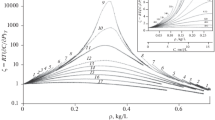Abstract
The surface properties of three SiO2 samples, one crystalline (quartz) and two amorphous, with a large difference in particle size, have been investigated by thermal analysis, adsorption calorimetry and infrared spectroscopy. The variation in the silanol group population upon thermal treatment has been followed via the evolution of the i.r. bands at 3745–3750 cm−1 (free hydroxyl groups) and 3650-3550 cm−1 (adjacent pairs of SiOH) and the evolution of the heat of adsorption of water with coverage on the outgassed samples.
The adsorption capacities increase in the sequence high surface area amorphous sample <low surface area amorphous sample <quartz. Dehydroxylation of the surface leads to an increasing hydrophobic character shape of the isotherm, heat of adsorption below the heat of liquefaction of water. The same thermal treatment (T=673 K) brings about dehydroxylation leaving only isolated silanols on the high surface area amorphous silica, and partial dehydroxylation of the low surface area material. Quartz is totally hydrophilic, as its regular structure probably stabilizes the hydroxyl layers at the surface.
Zusammenfassung
Die Oberflächeneigenschaften von einer kristallinen (Quarz) und zwei amorphen SiO2-Proben mit großen Unterschieden in der Partikelgröße wurden durch thermische Analyse, Adsorptionskalorimetrie und Infrarotspektroskopie untersucht. Bei thermischer Behandlung eintretende Veränderungen in der Silanolgruppenpopulation wurden durch Messung der IR-Banden bei 3745–3750 cm−1 (freie Hydroxylgruppen) und 3650–3550 cm−1 (benachbarte SiOH-Paare) und der Adsorptionswärme von Wasser an ausgeheitzten Proben untersucht. Die Adsorptionskapazitäten nehmen in folgender Reihenfolge ab: amorphe Probe mit großer Oberfläche > amorphe Probe mit geringer Oberfläche > Quarz. Dehydroxylierung der Oberfläche hat zunehmenden hydrophoben Charakter (Gestalt der Isothermen, Adsorptionswärme kleiner als Kondensationswärme von Wasser) zur Folge. Bei der gleichen thermischen Behandlung (673 K) werden bei amorphen Siliciumdioxid mit großer Oberfläche eine nur isolierte Hydroxylgruppen zurücklassende Dehydroxylierung und bei Material mit kleiner Oberfläche eine teilweise Dehydroxylierung beobachtet. Quarz ist vollkommen hydrophyl, da die reguläre Struktur wahrscheinlich die Hydroxylschichten an der Oberfläche stabilisiert.
Резюме
Методом термическог о анализа, адсорбцион ной калориметрии и инфра красной спектроскопии иссле дованы поверхностны е свойства трех образцов двуоки си кремния, из которых один был крис таллическим (кварц), а о стальные два — аморфными с разл ичным размером частиц. За из менением плотности с иланольных групп при термическо й обработке образцов следили по И К полосам при 3745–3750 см−1 (свободные гидроксил ьные группы) и при 3650–3550 см−1 (смежные пары г рупп SiOH), а также по выдел ению теплот адсорбции вод ы дегазированными обр азцами. Адсорбционны е способности увеличи ваются в ряду аморфны й образец с большой пло щадью поверхности < ам орфный образец с малой площа дью поверхности < кварц. Ст епень дегидроксилир ования вызывает увеличение гидрофобного характера образцов (в ид изотермы, теплота а дсорбции ниже теплоты сжижени я воды). Термическая обработ ка (T=673 K) вызывает дегидроксилировани е только изолированн ых силанольных групп в а морфном образце с бол ьшой площадью поверхност и и частичное дегидроксилировани е в образце с малой пло щадью поверхности. Кварц яв ляется полностью гидрофильным, так его упорядоченная струк тура, вероятно, стабилизир ует гидроксильные сл ои на поверхности.
Similar content being viewed by others
References
H. P. Boehm, Adv. Catal., 16 (1966) 226.
G. J. Young, J. Colloid Sci., 13 (1958) 67 and G. J. Young and T. P. Bursh, ibidem 15 (1960) 361.
V. Bolis, B. Fubini and G. Venturello, J. Thermal Anal., 28 (1983) 249.
B. Fubini, Rev. Gén. Therm., 18 (209) (1979) 297.
E. Borello, A. Zecchina and M. Castelli, Ann. Chim. Rome, 53 (1963) 690.
D. Dollimore, Thermochim. Acta, 50 (1981) 123.
C. Frondel, The System of Mineralogy of DANA, Silica Minerals, Wiley, New York, 1962, Vol. 3, p. 154.
R. K. Iler, The Chemistry of Silica, Wiley Interscience, New York, 1979, pp. 622 and 730.
K. Klier, J. H. Shen and A. C. Zettlemoyer, J. Phys. Chem., 77 (1973) 1458.
B. Fubini, V. Bolis and E. Giamello, Thermochim. Acta, 85 (1985) 23.
J. Texter, K. Klier and A. C. Zettlemoyer, Progress in Surface and Membrane Science, Academic Press Inc., New York, 1978, Vol. 12, p. 339.
H. Knözinger, The Hydrogen Bond, P. Schuster, G. Zundel and C. Sandorfy eds., North Holland, Amsterdam, 1976, Vol. 3, p. 1263.
Author information
Authors and Affiliations
Additional information
This research was supported by the Ministry of Public Education within a national programme relating to the structure and reactivity of surfaces.
Rights and permissions
About this article
Cite this article
Bolis, V., Fubini, B., Coluccia, S. et al. Surface hydration of crystalline and amorphous silicas. Journal of Thermal Analysis 30, 1283–1292 (1985). https://doi.org/10.1007/BF01914297
Issue Date:
DOI: https://doi.org/10.1007/BF01914297




